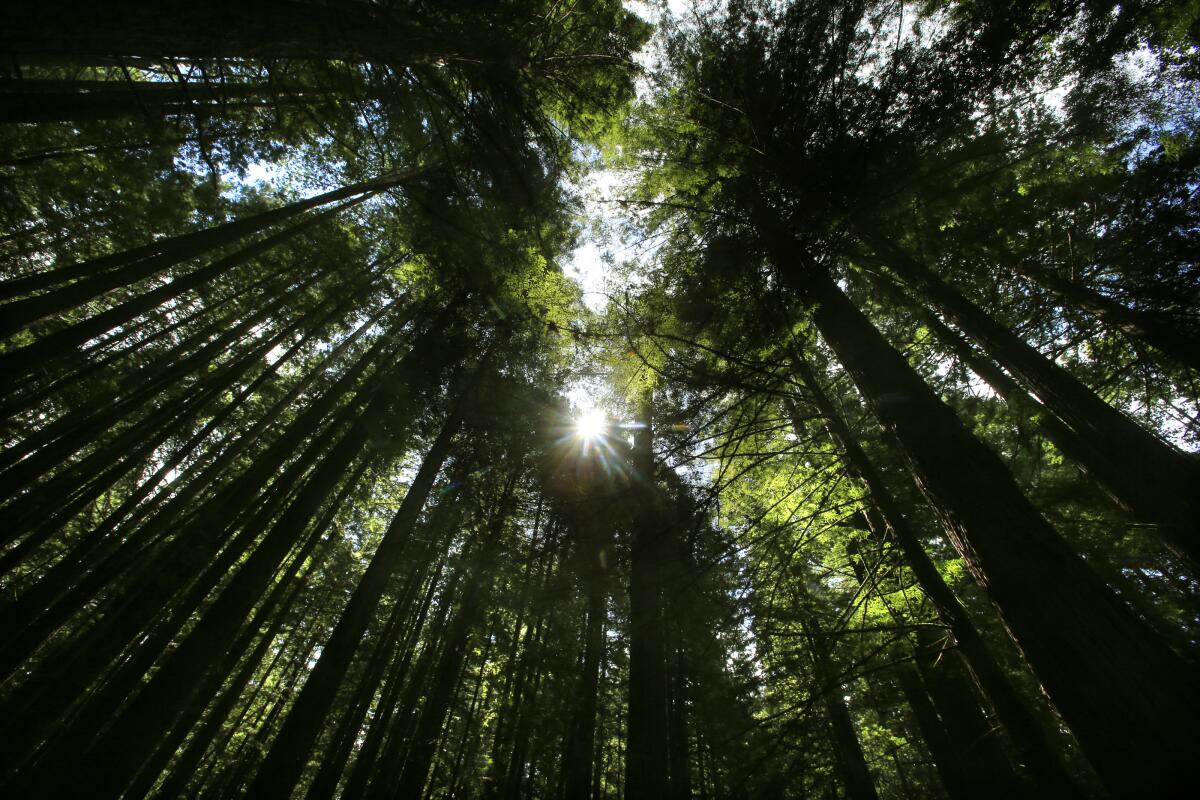Plants have something to say about climate. A new study unlocks their ‘language’

- Share via
Good morning. It’s Thursday, Sept. 28. Here’s what you need to know to start your day.
- How researchers learned to understand the language of plants
- California’s new reproductive health laws
- 11 iconic L.A. homes you can tour
- And here’s today’s e-newspaper
Sign up for Essential California
The most important California stories and recommendations in your inbox every morning.
You may occasionally receive promotional content from the Los Angeles Times.
Plants have something to say about climate. UCLA researchers learned their language
California is between droughts right now, but scientists say climate change will fuel more severe dry spells in the Golden State in the coming decades.
Humans can express their discomfort with heat, drought and other environmental conditions easily. But according to new research from UCLA biologists, plants are also communicating their ideal conditions in their leaves and wood. Biologists say that could help us better protect native species as we adapt to a changing climate.
The study, published this month in the journal Functional Ecology, outlines researchers’ work collecting samples from more than 100 tree and shrub species in six different California ecosystems. They examined 10 physiological plant traits, including height; leaf size and wilting point; the nutrients and other chemical compositions in their leaves; and the density of their wood.
Scientists then created a statistical model to predict the climate conditions each plant species preferred, including average temperature, rainfall and aridity. The study also identified species with a “trait-climate mismatch” — those currently growing in a region that is not ideal for them.
Scientists have long known that plant species spent millions of years adapting to the environments they grow in. But this study did something new, said senior author Lawren Sack, a UCLA professor of ecology and evolutionary biology.
“While people have shown the [plants’] traits relate to climate, nobody has then turned it around and used them to predict the climate the plants prefer,” he told me.
Sack noted that the study focuses on the average climate that plants prefer and not simply the thresholds those plants can tolerate — such as the highest temperature or least rain.
Lead author and UCLA postdoctoral scholar Camila Medeiros said the predictions can be used to determine which species are most at risk, which could inform conservation efforts.
“As climate change ensues, we think this will tend to aggravate the sensitivity of many species, including common trees like the California buckeye and shrubs like the purple sage and California lilacs,” Medeiros said in a news release.
Researchers didn’t expect as much diversity among plants as they ended up finding by examining their traits, Sack said. That could have some major implications for our forest ecosystems in the future, he explained:
“As droughts get worse, you’re going to get a really strong change of the species in terms of their dominance within the ecosystems… where previously common species become less common, previously less common become more common.”
Sack said he hopes the research will help Californians see climate change as an all-species struggle now that plants’ unique “language” has been unlocked.
“This is a way for plants to tell us what climate they want to occupy,” he said. “We should try to keep [our] climate stable for all of the organisms, for all of the ecosystem and not just think about ourselves.”
Today’s top stories

Republican debate
- 5 takeaways from last night’s Republican presidential debate.
- As GOP presidential candidates debate, Democrats unleash a top attack dog: Gov. Gavin Newsom.
- President Biden is talking democracy. But former President Trump is winning on the economy.
- The Republican debate has an unplanned theme: This isn’t Ronald Reagan’s party anymore.
Health
- A new law allows doctors living in ‘hostile’ red states to get abortion training in California.
- LAUSD ends its COVID-19 vaccine mandate for staff. Displaced workers can apply for openings.
Local politics
- A frequent GOP L.A. congressional candidate was charged with misusing campaign funds.
- L.A. County supervisors order a crackdown on small-business fraud after a three-year delay.
- The Los Angeles City Council approves a new ethics commissioner after rejecting a previous nominee.
Hollywood strikes
- SAG-AFTRA and the studios to resume talks.
- Screenwriters secured a new deal for AI. For actors, the fight could be even harder.
- Now that the writers’ strike has ended, showrunners wonder how they begin moving forward.
- False starts, secret talks: Insiders tell how the writers’ strike ended with ‘Let’s make a deal’
More big stories
- Is hydropower good or bad for the environment? We went to Idaho to find out.
- In Men’s Central Jail, fires are common and smoke alarms are not: Smells ‘like a campfire’
- Long Beach police officers were acquitted of perjury and filing false reports.
- Applications for L.A.’s emergency rent assistance close soon.
- Armenian Americans say another genocide is underway in Nagorno-Karabakh and are rallying for U.S. action.
- Is SoFi Stadium dangerous for fans? A study indicates many other NFL venues are worse.
Get unlimited access to the Los Angeles Times. Subscribe here.
Commentary and opinions
- Steve Lopez: Is age really just a number? Not when it comes to Biden and Trump.
- Gustavo Arellano: For nearly a century, this camp has hosted city children. Tropical Storm Hilary destroyed it.
- Op-ed: I spent 22 years in prison for a crime that never happened. That’s not even the worst part.
- Harry Litman: Is it time for a federal judge to put a gag order on Donald Trump?
Today’s great reads
Sexual harassment allegations, infighting, labor unrest: The unraveling of Hollywood Legion Theater. How did this ambitious passion project meant to connect the post’s historical Hollywood roots with an industry-driven, service-oriented future go so terribly awry?
Other great reads
- The voice of god: In an industry that is predominantly white and male, Queen Noveen is well aware that she’s one of few successful Black voice-over performers.
- This art restorer gets the energy to focus intently on the smallest details of an object through body surfing, tai chi and strategic fasting.
- Meet Melanie Barcenas, the 15-year-old Latina trailblazer in the National Women’s Soccer League.
How can we make this newsletter more useful? Send comments to essentialcalifornia@latimes.com.
For your downtime
Going out
- 🏠 11 iconic L.A. homes you can tour in real life: Frank Lloyd Wright, Neutra, Eames and more.
- 📁 The archive is the art at this Hammer Biennial ‘Made in L.A.’ exhibit.
- 🏈 For the first time since it opened in 2020, SoFi Stadium will host an official high school football game.
Staying in
- 📚 In their novel, ‘People Collide,’ Isle McElroy mashes up two fiction tropes — marriage on the rocks and body-switch caper — into a sharp critique of gender roles.
- 📺 Bedroom and boardroom intrigue abounds in Netflix’s wickedly entertaining ‘Fair Play’.
- 🌹 ‘The Golden Bachelor’ starts tonight. That’s 22 women and a second chance at love for Gerry Turner.
- 🧑🍳 Here’s a recipe for buttermilk biscuits.
- ✏️ Get our free daily crossword puzzle, sudoku, word search and arcade games.
And finally ... from our archives
Warsaw fell to the Nazis on Sept 27, 1939. The front page of the Los Angeles Times focused on the war every day that week as Germany and Russia signed a peace accord, split Poland between them and looked to force the Allies into a quick peace.
Read more from our 50-year look back in 1989: Scars of War Linger on People, Land : Poland 50 Years Later: Enduring Sense of Loss
Have a great day, from the Essential California team
Ryan Fonseca, reporter
Elvia Limón, multiplatform editor
Laura Blasey, assistant editor
Karim Doumar, head of newsletters
Check our top stories, topics and the latest articles on latimes.com.
Sign up for Essential California
The most important California stories and recommendations in your inbox every morning.
You may occasionally receive promotional content from the Los Angeles Times.










